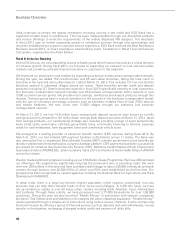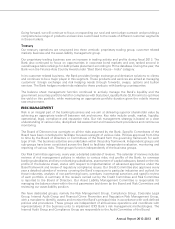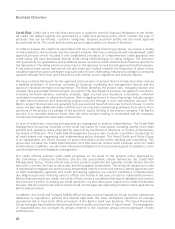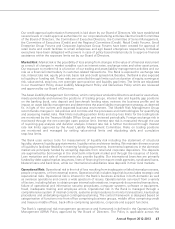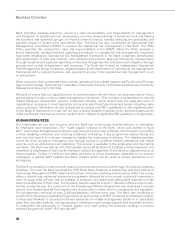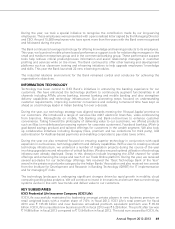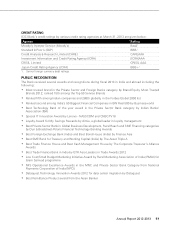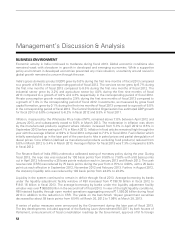ICICI Bank 2013 Annual Report Download - page 49
Download and view the complete annual report
Please find page 49 of the 2013 ICICI Bank annual report below. You can navigate through the pages in the report by either clicking on the pages listed below, or by using the keyword search tool below to find specific information within the annual report.
Annual Report 2012-2013 47
Our credit approval authorisation framework is laid down by our Board of Directors. We have established
several levels of credit approval authorities for our corporate banking activities like the Credit Committee
of the Board of Directors, the Committee of Executive Directors, the Committee of Senior Management,
the Committee of Executives (Credit) and the Regional Committee (Credit). Retail Credit Forums, Small
Enterprise Group Forums and Corporate Agriculture Group Forums have been created for approval of
retail loans and credit facilities to small enterprises and agri based enterprises respectively. Individual
executives have been delegated with powers in case of policy based retail products to approve financial
assistance within the exposure limits set by our Board of Directors.
Market Risk: Market risk is the possibility of loss arising from changes in the value of a financial instrument
as a result of changes in market variables such as interest rates, exchange rates and other asset prices.
Our exposure to market risk is a function of our trading and asset-liability management activities and our
role as a financial intermediary in customer-related transactions. The Bank is exposed to exchange rate
risk, interest rate risk, equity price risk, basis risk and credit spread risk. Besides, the Bank is also exposed
to liquidity or funding risk. These risks are controlled through limits such as duration of equity, earnings at
risk, value-at-risk, stop loss, net overnight open position and liquidity gap limits. The limits are stipulated
in our Investment Policy, Asset Liability Management Policy and Derivatives Policy which are reviewed
and approved by our Board of Directors.
The Asset Liability Management Committee, which comprises wholetime Directors and senior executives,
meets periodically and reviews the positions of trading groups, interest rate and liquidity gap positions
on the banking book, sets deposit and benchmark lending rates, reviews the business profile and its
impact on asset liability management and determines the asset liability management strategy, as deemed
fit, in light of the current and expected business environment. The Market Risk Management Group
recommends changes in risk policies and controls and the processes and methodologies for quantifying
and assessing market risks. Risk limits including position limits and stop loss limits for the trading book
are monitored by the Treasury Middle Office Group and reviewed periodically. Foreign exchange risk is
monitored through the net overnight open position limit. Interest rate risk is measured through the use
of re-pricing gap analysis and duration analysis. Interest rate risk is further monitored through interest
rate risk limits approved by the Asset Liability Management Committee. Risks on trading positions
are monitored and managed by setting value-at-risk limits and stipulating daily and cumulative
stop-loss limits.
The Bank uses various tools for measurement of liquidity risk including the statement of structural
liquidity, dynamic liquidity gap statements, liquidity ratios and stress testing. We maintain diverse sources
of liquidity to facilitate flexibility in meeting funding requirements. Incremental operations in the domestic
market are principally funded by accepting deposits from retail and corporate depositors. The deposits
are augmented by borrowings in the short-term inter-bank market and through the issuance of bonds.
Loan maturities and sale of investments also provide liquidity. Our international branches are primarily
funded by debt capital market issuances, lines of financing from export credit agencies, syndicated loans,
bilateral loans and bank lines, while our international subsidiaries raise deposits in their local markets.
Operational Risk: Operational risk is the risk of loss resulting from inadequate or failed internal processes,
people or systems, or from external events. Operational risk includes legal risk but excludes strategic and
reputational risks. Operational risk is inherent in the Bank’s business activities in both domestic as well
as overseas operations and covers a wide spectrum of issues. Operational risk can result from a variety
of factors, including failure to obtain proper internal authorisations, improperly documented transactions,
failure of operational and information security procedures, computer systems, software or equipment,
fraud, inadequate training and employee errors. Operational risk in the Bank is managed through a
comprehensive system of internal controls, systems and procedures to monitor transactions, key backup
procedures and undertaking regular contingency planning. The control framework is designed based on
categorisation of functions into front-office comprising business groups, middle office comprising credit
and treasury middle offices, back-office comprising operations, corporate and support functions.
The Bank’s operational risk management governance and framework is defined in the Operational Risk
Management (ORM) Policy approved by the Board of Directors. The Policy is applicable across the









